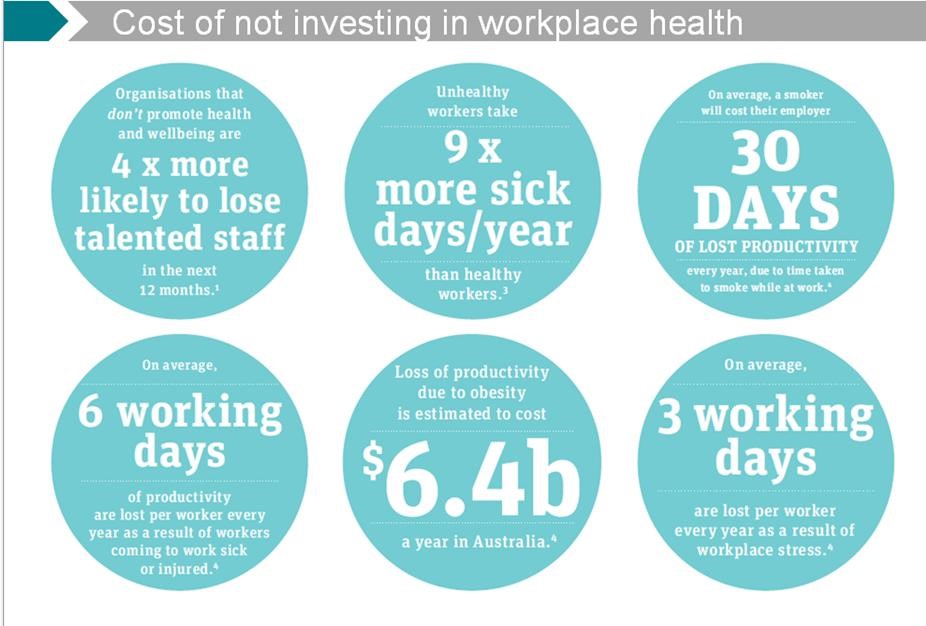
What are the benefits of wellness in the workplace? Did you know that approximately 60% of employees would opt to remain at their current job if their company offered a wellness program, and 78% would participate in an employee-sponsored wellness program?
The Harvard Business Review broke down the value of employee wellness programs for employers. According to their assessment, at least one major company saved nearly $250 million on healthcare over a decade as the result of their wellness program. This company’s average return was nearly $3 for every dollar spent. Even though this is just one example, it’s a great illustration of what employers stand to gain with a well-designed, properly executed employee wellness program.
According to the U.S. Department of Health and Human Services, employers with wellness programs cut their healthcare bill by as much as 55%. The report also noted that the number of short-term sick leaves was reduced by as much as 32%. Employee wellness programs also increased workplace productivity by up to 52% in this report.
Other benefits of wellness programs for employees in the workplace include:
- Healthier employees. Most employee wellness programs can effectively help employees lose weight and reduce stress. But, wellness programs can be designed to improve health in a variety of ways. The sky is the limit. It comes down to what your employees need, so be sure to ask for their input.
- Cheaper healthcare. With climbing healthcare costs, it’s getting harder for companies to offer great healthcare while still protecting their bottom line. Even though a wellness program is an investment, its ability to reduce healthcare costs in the long run makes it worthwhile.
- Less absenteeism. Healthier employees don’t get sick as often or as bad as unhealthy employees. With unscheduled absenteeism costing employers almost $4,000 for hourly workers and almost $3,000 for salaried employees, it’s easy to see why a wellness program that improves health and reduces absenteeism is enticing.1
- Better retention. Wellness programs are among the top benefits to watch in 2018, so it’s no surprise that offering one gives you an edge during recruitment. But, it also helps with retention. When employees value the wellness program their company provides, they’re less likely to leave.
- Increased productivity and a happier office. Productivity and happiness go hand-in-hand. When employees are happy, they’re more productive. A wellness program that improves happiness by helping employees lead healthier lives could increase workplace productivity by up to 12% or more!2
But, these aren’t the only workplace wellness benefits employers experience with an employee wellness program.
Research conducted by the Employee Benefit Research Institution (EBRI) shows that workplace wellness programs improve employees’ medication adherence. This outcome just goes to show that there are several ways to reduce healthcare costs with wellness programs.
Employees don’t always have to lose weight to reduce the size of your healthcare bill. Simply helping them stick to their medication regimen can reduce costs. So, the EBRI’s finding is huge considering many of the conditions that require strict adherence to a prescription drug treatment are expensive.

How Employees Benefit FROM WORKPLACE WELLNESS PROGRAMS
Employees also gain a lot from wellness programs. For example, studies consistently report that wellness programs benefit employees in the following ways:
- Better stamina/physical fitness. Wellness programs help employees improve their muscle tone and physical stamina, which is essential considering how much time the average employee spends sitting at their office desk. According to a survey featured by the American Chiropractic Association, back pain is the leading cause of disability and half of American workers will experience painful back problems at some point in time, largely due to poor posture and too much time in an office chair. Wellness programs can mitigate and prevent such problems by boosting physical stamina, improving posture, and encouraging movement.
- Weight loss. By offering employees a program and/or space to improve their health, you give them a chance to drop those unwanted pounds, and that has a huge impact on their self-confidence and general well-being. Fortunately, you don’t need to invest a lot to help employees lose weight. A workplace walking program offered in conjunction with a nutrition coach or nutrition program is really all you need.
- Stress reduction. When employees are encouraged to take care of themselves they often experience a reduction in stress which has a profound impact on their day, their home life, and their happiness.
- Improved well-being. Healthier employees feel better. A wellness program is a structured way to help employees feel like a million bucks.
Employees can also reduce their risk for various diseases by losing weight, reducing stress, and practicing self-care—all of which are outcomes that wellness programs seek to achieve.
What Features Do Popular Wellness Programs Offer?
Successful wellness programs take employee needs and wants into consideration. They also provide:
- Personalization. Three out of four people want the wellness program they participate in to have a personal touch.3 Employers can provide this by connecting employees to a likeable expert capable of helping them with their goals. This expert could be a nutritionist, personal trainer, life coach, etc. There are a variety of options.
- Convenience. Having a facility on-site where employees can exercise is essential. Employees are far more likely to participate in healthy behaviors when those behaviors are convenient. Being able to exercise at work is extremely convenient. Fortunately, employers don’t have to build an in-office gym. If you can clear out a conference room, you have space for yoga, step aerobics, and light resistance training.
- Mental health support. Diets frequently lead to binge eating and white knuckling never works in the long run. Wellness programs that consider the mental-emotional aspect of health tend to be more successful in the long-run because employees are taught to be kinder to themselves. They learn about self-care and are encouraged to take small, manageable steps forward.
When workplace wellness programs are done right, employees really love the benefits of them.
Hit The “Sweet Spot”
Employers that offer a wellness program and competitive benefits packages will have an advantage in the years to come as employees become more selective about where they work. So, now is the time to look for a reliable partner to help you create and manage workplace wellness benefit services. Clarity is a benefits administration and HRA company offering health reimbursement account administration and more. Learn more about the benefits of wellness programs for employees and how Clarity can meet your needs in the workplace today.
Sources:
1. https://www.investopedia.com/articles/personal-finance/070513/causes-and-costs-absenteeism.asp
2. http://www.snacknation.com/blog/employee-happiness/
